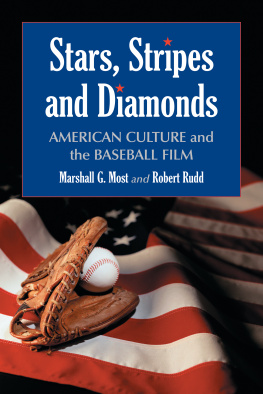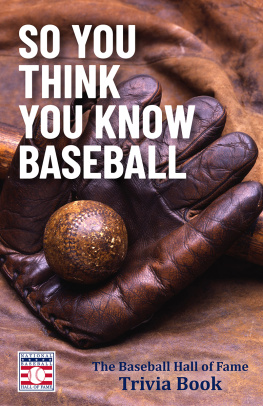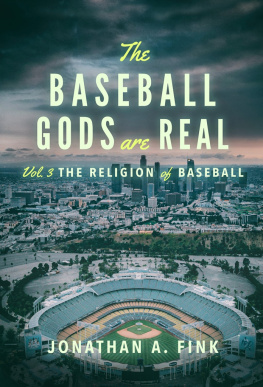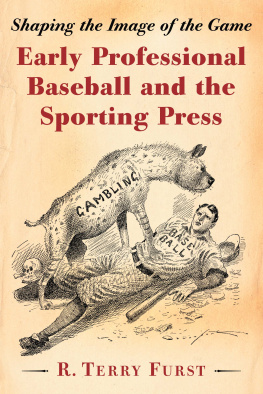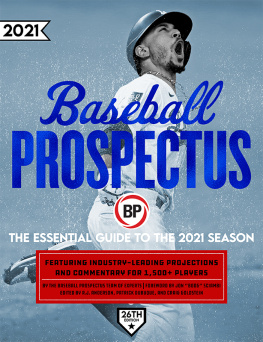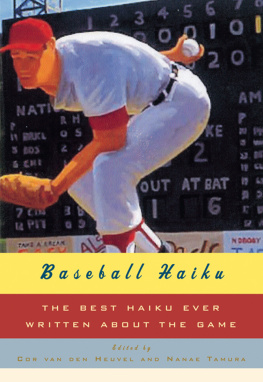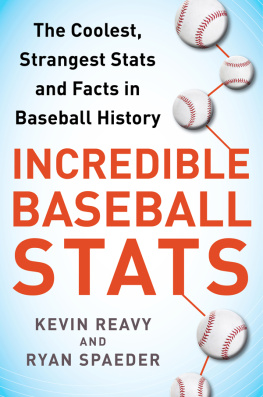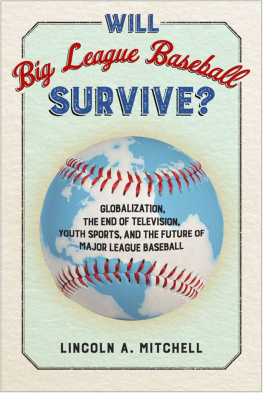Stars, Stripes and Diamonds
American Culture and the Baseball Film
MARSHALL G. MOST AND
ROBERT RUDD

McFarland & Company, Inc., Publishers
Jefferson, North Carolina
LIBRARY OF CONGRESS CATALOGUING DATA ARE AVAILABLE
BRITISH LIBRARY CATALOGUING DATA ARE AVAILABLE
e-ISBN: 978-1-4766-3462-3
2006 Marshall G. Most and Robert Rudd. All rights reserved
No part of this book may be reproduced or transmitted in any formor by any means, electronic or mechanical, including photocopyingor recording, or by any information storage and retrieval system,without permission in writing from the publisher.
Cover photograph 2006 Photodisc
McFarland & Company, Inc., Publishers
Box 611, Jefferson, North Carolina 28640
www.mcfarlandpub.com
For Jake and Crickett
Acknowledgments
The work you hold is the culmination of research that began late in 1990. Our original intention was modestto produce a paper for the Third Cooperstown Symposium on Baseball and American Culture. The product of that initial effort was equally modesta 23-page paper that drew upon a sample of only four films and focused on a single aspect of baseballs ideology as portrayed by Hollywood. We realized even before it was finished that a single paper would never begin to cover all the dimensions of baseballs cultural vision as expressed in American motion pictures about the National Pastime. With the kind assistance of a number of individuals, our research has been significantly broadened, the sample of films increased to more than 100, and a number of conference papers, journal articles and book chapters have been produced.
No one has been more helpful to us in our research than Steven Wood, of the University of Rhode Island and J. David Pincus, of the University of Arkansas, versatile scholars and baseball film researchers of some renown. We thank them not only for their assistance in the preparation of this manuscript, but also for their interest in, support of and thought-provoking discussions about our research, conversations that date back to the early 1990s. Our colleagues at Boise State University have always seemed a bit skeptical about research that sounded like it might be too much fun to be scholarly. They have, nevertheless, consistently supported the 15-year research agenda that made this volume possible. We appreciate our associates in the Department of Communication at Boise State, as well as our colleagues in the College of Social Sciences and Public Affairs, who supported our research with timely grants for research and travel. Such grants were often made by committees of fellow faculty members too numerous to mention. Deans include Dr. Michael Blankenship, Dr. Suzanne McCorkle, Dr. Jane Ollenburger and Dr. Robert Sims; and department chairs include Dr. Rick Moore, Dr. V. Marvin Cox and Dr. Robert Boren. Wed also like to thank our colleague Jane Freund for her help in putting together scene-by-scene summaries of many of the films we have viewed, and Erich Korte of Laughing Dog Press for his assistance with the photos.
We also extend our appreciation to Alvin Hall of East Stroudsburg University and all those at the National Baseball Hall of Fame and the State University of New York at Oneonta who have worked with Al to sustain the Cooperstown Symposium. The Symposium has afforded us and many other researchers a unique support system, providing a wonderful outlet for scholarly work on baseball and culture in an unparalleled venue.
Special thanks are extended to our wives, to whom this volume is dedicated, and to our other family members, for their loving support and interest (real and feigned) in our work.
And finally, our efforts over these many years were made easier by Jymson and Babba Luey, and their successors, Andre and Jack, companions who occupied our laps and inspired our writing (especially about Rhubarb) as we worked at our computers. Good kitties!
Preface
As the writing of this book was completed, one of baseballs most well-known playersa man once considered a lock for election to the Baseball Hall of Fameserved a 10-day suspension for violating the games ban on the use of steroids. The story was front-page news, receiving the level of attention that days before was reserved for such issues as the Iraq War, the economy, and famine in Africa. As sports commentators expressed their outrage, as Congress once again demanded the game be cleaned up once and for all, and as baseball fans across America lamented this latest tarnishing of the national pastime, one cannot help but wonder why this matters so much to us. Why do we care so deeply about this? In many ways, that is the central question addressed in this book.
In the film Field of Dreams, author Terence Mann, played by James Earl Jones, tells us that this field, this game, is a part of our past. It reminds us of all that once was good, and that could be again. Quite simply, this is why the transgressions of one of the games stars means so much. We have come to believe that America and the game of baseball are somehow intimately connected. At the most fundamental level, the identities of both baseball and America are deeply and inextricably intertwined. In the popular imagination baseball stands for all that is good about America. We have come to believe that the tarnishing of the game and what it stands for is also a degradation of America itself.
In the discussions which follow, we explore the nature of those connections between the game of baseball and American culture as they are represented in baseball films. All film, of course, serves to both reflect and shape cultural values and beliefs. At the same time that films represent and reflect something within the cultural consciousness at the time they are produced, they also help to form that consciousness. But this is especially true of baseball films, we believe, which articulate a vision and a set of core values that have been a part of the American mainstream since well before the emergence (we hesitate to use the term invention, given the contested history of the game) of the game itself in the late 19th century. Baseball films present not just an idealized view of the game and its heroesand they are heroes in our culturebut also an idealized vision of America itself. And, in doing so, they contribute in a significant way to that cultural intertwining of the values and identities of baseball and America.
We begin in Chapter 1 with a review of the history and the central components of baseballs cultural visiona vision which has been faithfully represented in baseball films since the earliest days of cinema. In Chapter 2, we provide a chronological review of baseball films since the late 1800s, offering brief narrative summaries of nearly 100 different films. In addition to providing an overview of the themes and central storylines of the past 100-plus years of baseball films, this chapter is intended to help the reader understand the historical context and evolution of baseball films through different eras, and in doing so to lay the groundwork for the analyses of the ideological dimensions of those films which follow.
Chapter 3 explores the theme of community in baseball films. The concept of community is central to baseballs cultural vision, and has thus been a primary theme of baseball films. In these films, viewers are offered images of idealized communities characterized by solidarity, equality, and diversity, in which individuals willingly put the good of the team/community first. In Chapters 4 and 5, we examine the ways the baseball herothe idealized citizen of those baseball communitiesare portrayed in baseball films. Chapter 4 focuses on the traditional, Puritanical moral code of the cinematic baseball hero, and Chapter 5 analyzes the motivations of the baseball hero. In sharp contrast to the seeming obsession of real-life baseballs superstars with lottery-sized contracts, baseballs cinematic heroes care little about the monetary rewards, playing the game simply for love of the game itself. This theme of devotion to the game is explored more fully in Chapter 6, in which we consider the treatment of the issue of gambling in baseball films, and Chapter 7, in which we examine representations of baseball owners in baseball cinema.

